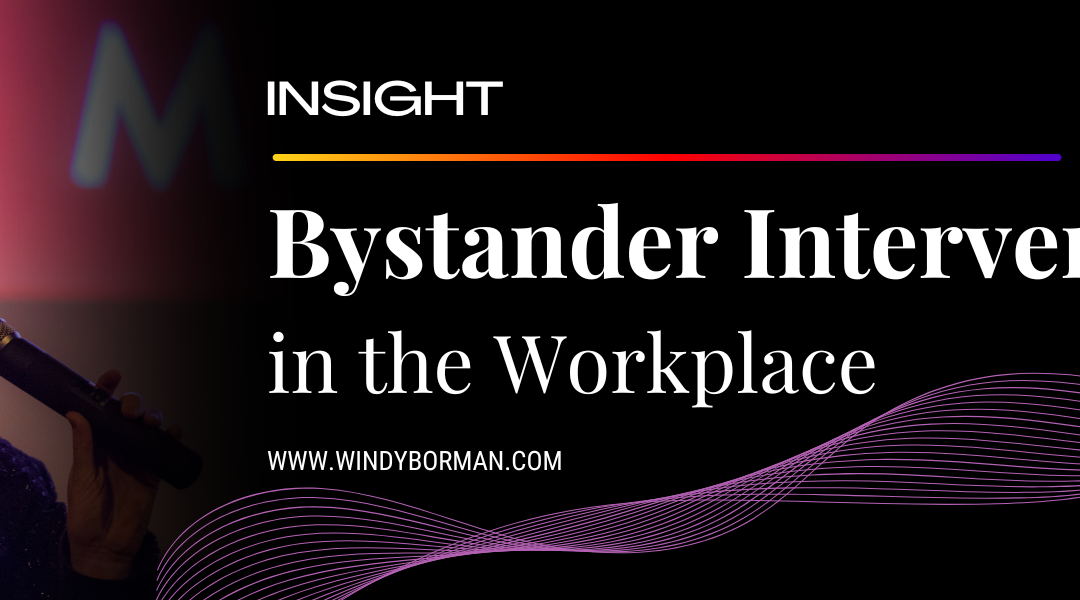We’ve heard the advice: “If you see something, say something”. However, many of us struggle with saying something in the moment. Perhaps our voice fails us and we can’t find the words. Perhaps we worry about causing more harm to the person in danger, the perpetrator of the violence, ourselves, or our community.
Bystander Intervention is recognizing a potentially harmful situation or interaction and choosing to respond in a way that could positively influence the outcome.
At its core, Bystander Intervention has three goals:
- Support someone who is being harassed,
- Emphasize that harassment is not okay, and
- Demonstrate to people in your life that they too have the power to make our communities and workplaces safer.
This contrasts with the “Let me speak to your Manager” (a.k.a. “Karen”) energy that is punitive or seeks a negative outcome.
In August 2023, I co-hosted a Bystander Intervention webinar with Right To Be as part of my Intro to Consent on Set series. Right To Be’s methodology for Bystander Intervention is collectively known as “The 5 Ds”, which stands for: Distract, Delay, Document, Delegate, and Direct communication. I was relieved and empowered to learn there are four (4) other methods to intervene besides saying, “Stop that!”
Recently, I worked as an Event Producer for a Tech Company. During my contract, I witnessed and experienced behavior that required bystander intervention. In the spirit of harm reduction and demystifying how to intervene when you witness disrespect in the workplace, below I have shared my experience and takeaways using “The 5 Ds” Methodology.
Background
The Tech Company’s Art Department made late-night content changes before an early Show Day. This meant most of the content and cues were new to the show team on Show Day. Additionally, we only had two (2) hours before the doors opened, the Tech Company President was en route, and everyone had a late evening rehearsal plus an early call time. As a result, stress levels were running high that morning.
The Incident
When the Tech Company President arrived late for his walk-through, our Graphics Operator was not at his desk. The Tech Company Art Department person had given him more last-minute changes after the Cue-to-Cue, which meant he missed the scheduled crew break. Via the full Show Team radio channel, the Tech Company’s Account Sponsor asked for the Graphics Operator. Someone else on the crew replied he had run to the bathroom and was not available. The Account Sponsor asked, “When our President is on stage?” The crew member replied, “We are human beings”.
At this point, I intervened and attempted to de-escalate the situation by calmly saying on the radio, “Everyone is doing a great job. Take a breath”. I followed up with the Account Sponsor and the video team individually after this incident.
Bystander Intervention
I understand when people are under stress, they are not their best selves. However, Bystander Intervention teaches us that when we witness harassment, abuse, or harm in the workplace, we have 5 choices: Distract, Delay, Document, Delegate, and Direct communication.
When I witnessed this incident, I chose to distract (through a compliment and a reminder to breathe) and then delay (through checking in with people afterward). As an Independent Contractor, I did not know who to delegate the reporting to, so I documented it in a letter and sent it after they paid my invoice.
Distract, Delay, Document: that makes three (3) of “The 5 Ds” from the Right To Be methodology.
Takeaways
My Takeaways to reduce harm and foster consent at future events include:
- Start with Consent First. I was not hired as a Consent-Forward Artist on this production. If I had, I would have explained consent cannot be an afterthought. Ignoring people’s boundaries erodes trust, creates harm, and opens companies up to liability. Instead, if you start from a place of consent, you increase safety, which decreases liability and increases creativity. It’s a win-win scenario.
- Better Planning: You may have heard the saying, “An ounce of prevention is worth a pound of cure”. If the companies had been better prepared leading up to the event, the show team could have avoided the late night, last-minute changes, and rushed Cue-to-Cue. This would have decreased the stress and provided more space for people to be their best selves.
- More Transparency: As an Independent Contractor for the Event Company, I was unaware of the official reporting policies and protections they offer for contracted workers. To this day, I am also unaware of any protections for retaliation against me for reporting this incident. Having a transparent reporting process would demystify the process and offer more accountability for all sides.
- Sign and Review a Code of Conduct: Another way to avoid harm is to have everyone—including employees of the Event Company and the Tech Company—sign a Code of Conduct. Going through the expectations again on site, whether through a Safety Meeting or a Morning Meeting, would remind everyone to treat people with respect and how to report unprofessional behavior or harm if they occur.
Together these steps would dissuade people from doing or saying anything that could be considered disrespect, harassment, or abuse because everyone understood the consequences of that behavior.
You can sign up for a free Right To Be online training HERE
What questions or experiences do you have regarding Bystander Intervention? Add a comment or send me a note.


